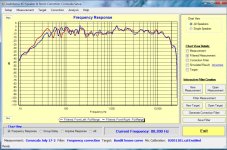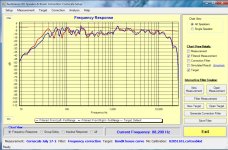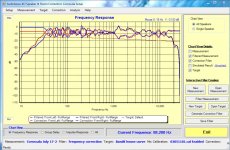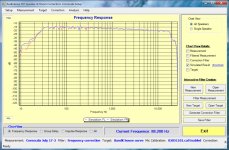re: DRC software
I use Bernt's AudioLense software at Juice HiFi Personally, I can't live without it.
If you want to know more, let me know and I can post a few pics of the results I got using this software.
Regards,
Mitch
I use Bernt's AudioLense software at Juice HiFi Personally, I can't live without it.
If you want to know more, let me know and I can post a few pics of the results I got using this software.
Regards,
Mitch
I use Audiolense with Windows 7 64bit OS. I use JRiver's Media Center software J. River Media Center software and a Convolver plug in Convolver — a convolution plug-in. This is coupled with a Lynx L22 sound card Lynx L22
The idea is that you use a calibrated measurement mic like iSEMcon GmbH and Audiolense uses a swept sine wave to output from your speakers and measures the frequency response, impulse response, etc., for your speakers and room.
Then in Audiolense, you draw a target frequency response curve as to how you want your system to sound at the listening position. As an ex recording engineer, I always gravitated to the B&K "house curve" that you can see in Figure 5 here: http://www.bksv.com/doc/17-197.pdf
Most recording studios will have at least one monitoring system equalized to this curve as it produces the most natural timbre at the mix position. It also solves the problem of engineers moving from one studio to the next and have their mix's sound the same (timbre).
Once you have drawn your target curve, you ask Audiolense to generate the filters which then plug into the Convolver VST in JRiver Media Center software.
It literally takes me 10 minutes from setting up, measuring the sound system, drawing the curve, generating the filters, plugging them in, and listening to tunes.
Attached is the raw measurement of my speakers/room combo. Then the same house curve like the B&K one above is drawn, the filters generated and then the final response at the listening position. I think the measurements speak for themselves. For me to hear the same timbre that I heard in the recording studio control room monitors on my home system is a dream come true.
The story does not end there, as Audiolense not only corrects for frequency response DRC, but also time aligns the signal at all frequencies to arrive at the listening position at the same time, has its own filter designer, and other cool capabilites, but that is another story.
Hope that helps.
Regards, Mitch
The idea is that you use a calibrated measurement mic like iSEMcon GmbH and Audiolense uses a swept sine wave to output from your speakers and measures the frequency response, impulse response, etc., for your speakers and room.
Then in Audiolense, you draw a target frequency response curve as to how you want your system to sound at the listening position. As an ex recording engineer, I always gravitated to the B&K "house curve" that you can see in Figure 5 here: http://www.bksv.com/doc/17-197.pdf
Most recording studios will have at least one monitoring system equalized to this curve as it produces the most natural timbre at the mix position. It also solves the problem of engineers moving from one studio to the next and have their mix's sound the same (timbre).
Once you have drawn your target curve, you ask Audiolense to generate the filters which then plug into the Convolver VST in JRiver Media Center software.
It literally takes me 10 minutes from setting up, measuring the sound system, drawing the curve, generating the filters, plugging them in, and listening to tunes.
Attached is the raw measurement of my speakers/room combo. Then the same house curve like the B&K one above is drawn, the filters generated and then the final response at the listening position. I think the measurements speak for themselves. For me to hear the same timbre that I heard in the recording studio control room monitors on my home system is a dream come true.
The story does not end there, as Audiolense not only corrects for frequency response DRC, but also time aligns the signal at all frequencies to arrive at the listening position at the same time, has its own filter designer, and other cool capabilites, but that is another story.
Hope that helps.
Regards, Mitch
Attachments
refer my earlier post about compiling the damn soundcard driver....
What specific problem did you have with the soundcard driver?
What specific problem did you have with the soundcard driver?
Nothing really, it was just the last straw when I tried linux. A wisecrack really.
I was being a smartarse, not asking for help.
I use Audiolense with Windows 7 64bit OS. I use JRiver's Media Center software J. River Media Center software and a Convolver plug in Convolver — a convolution plug-in. This is coupled with a Lynx L22 sound card Lynx L22
The idea is that you use a calibrated measurement mic like iSEMcon GmbH and Audiolense uses a swept sine wave to output from your speakers and measures the frequency response, impulse response, etc., for your speakers and room.
Then in Audiolense, you draw a target frequency response curve as to how you want your system to sound at the listening position. As an ex recording engineer, I always gravitated to the B&K "house curve" that you can see in Figure 5 here: http://www.bksv.com/doc/17-197.pdf
Most recording studios will have at least one monitoring system equalized to this curve as it produces the most natural timbre at the mix position. It also solves the problem of engineers moving from one studio to the next and have their mix's sound the same (timbre).
Once you have drawn your target curve, you ask Audiolense to generate the filters which then plug into the Convolver VST in JRiver Media Center software.
It literally takes me 10 minutes from setting up, measuring the sound system, drawing the curve, generating the filters, plugging them in, and listening to tunes.
Attached is the raw measurement of my speakers/room combo. Then the same house curve like the B&K one above is drawn, the filters generated and then the final response at the listening position. I think the measurements speak for themselves. For me to hear the same timbre that I heard in the recording studio control room monitors on my home system is a dream come true.
The story does not end there, as Audiolense not only corrects for frequency response DRC, but also time aligns the signal at all frequencies to arrive at the listening position at the same time, has its own filter designer, and other cool capabilites, but that is another story.
Hope that helps.
Regards, Mitch
Create a thread.
DRC will do most of that, for free, but it's harder to use (no gui, no measurements, no crossover).
To me the value of audiolense comes with the phase coherent crossover - but it's not cheap.
I also own Allocator - which will do the phase coherent crossover, via a dirty hack/neat trick. (And I own Soundeasy UE, but I never got that to work.) Allocator + DRC will do me a phase coherent crossover and room correction.
Audiolense and Acourate seem to be the pick of the bunch - but you still need Convolver and a player (I use directshow Convolver + zoomplayer for movies, and JRMC + vst Convolver for audio already).
But they are both hideously expensive.
And I don't think you need a calibrated mic. A panasonic capsule is fine - a couple of dB here or there just doesn't matter.
Create a thread on how you got it all working with Audiolense. The post-audiolense implementation of the filters in convolver is also interesting (and tricky).
I imagine that if you are using the VST convolver then you are using a fixed sample frequency and channel number.
The directshow version is flexible that way, but I never found a player that will play tracks seamlessly.
I've pretty much documented how I got my system running with DRC and Convolver, I'm interested in how you got yours running in Audiolense.
Hmmm. I think we are talking about two related, but different things. You are talking about this software: DRC: Digital Room Correction Yes? I was talking about DRC the category Digital room correction - Wikipedia, the free encyclopedia and within that category, Audiolense and how I used to for me for DRC.
Not much to explain, I followed the Audiolense manual and everything worked perfectly - like I say takes 10 minutes. There is a section in the manual about plugging in the Convolver VST and the loading the filter files into JRiver - takes 10 seconds.
As an ex-recording engineer, you get taught to calibrate everything. Especially mneasurement mics - standard procedure. A couple of db here and there does matter and has an impact on the timbre of the sound - is it dark, bright or just right are all in a manner of a few db's tilt one way or another. See B&K critical listening article I linked to above.
As you say, Audiolense is the pick of the bunch. I agree.
All the best.
Not much to explain, I followed the Audiolense manual and everything worked perfectly - like I say takes 10 minutes. There is a section in the manual about plugging in the Convolver VST and the loading the filter files into JRiver - takes 10 seconds.
As an ex-recording engineer, you get taught to calibrate everything. Especially mneasurement mics - standard procedure. A couple of db here and there does matter and has an impact on the timbre of the sound - is it dark, bright or just right are all in a manner of a few db's tilt one way or another. See B&K critical listening article I linked to above.
As you say, Audiolense is the pick of the bunch. I agree.
All the best.
i used the DRC software after calibrating my receiver and soundcard equalizer.
it sounded good for about a day and i noticed the sound changed.
then..
about a year later my soundcard died.
so..
maybe it would be wrong for me to say the DRC program didnt sound very good.
i was using DRC with SIR impulse response processor and foobar with the vst host plugin.
you can find the SIR impulse response processor software here:
SIR Audio Tools / Free / SIR1
i like it because you can adjust the wet and dry signals.
really lets you load the impulse response file and choose how much sound you get from behind you.
and when you use it.. you dont have to worry about changing the impulse response file when switching between 44.1 khz and 48 khz
i never did, and it didnt ask or prompt about anything when switching from one sample rate to the other.
it sounded good for about a day and i noticed the sound changed.
then..
about a year later my soundcard died.
so..
maybe it would be wrong for me to say the DRC program didnt sound very good.
i was using DRC with SIR impulse response processor and foobar with the vst host plugin.
you can find the SIR impulse response processor software here:
SIR Audio Tools / Free / SIR1
i like it because you can adjust the wet and dry signals.
really lets you load the impulse response file and choose how much sound you get from behind you.
and when you use it.. you dont have to worry about changing the impulse response file when switching between 44.1 khz and 48 khz
i never did, and it didnt ask or prompt about anything when switching from one sample rate to the other.
Question on JRMC / Convolution
Why do you not use JRMC for video? Also, I'm interested in your thinking on the decision between a single Windows PC for Media Player / Convolution vs separate Windows PC for Media Player & Linux PC for Convolution. The single PC model seems simpler but it doesn't seem possible to allow for other digital sources (e.g., DVD or CDP for family use).
APS
Audiolense and Acourate seem to be the pick of the bunch - but you still need Convolver and a player (I use directshow Convolver + zoomplayer for movies, and JRMC + vst Convolver for audio already).
Why do you not use JRMC for video? Also, I'm interested in your thinking on the decision between a single Windows PC for Media Player / Convolution vs separate Windows PC for Media Player & Linux PC for Convolution. The single PC model seems simpler but it doesn't seem possible to allow for other digital sources (e.g., DVD or CDP for family use).
APS
A number of reasons:
1 - I've found that it's much easier to configure the directshow filters EXACTLY as I want them in Zoomplayer. I have a convoluted filter path, and I couldn't get them exactly how I want it in JRMC. I think it was something to do with Reclock...
2 - I've been running Zoomplayer for years, and am (sometimes) involved in the closed testing. Inertia - I use it because I use it. The quality can be equalled, but not bettered. It does the job.
3 - I like to keep things separate. I use WMP for casual listening (coz the wifey can use it), MPC-HC for casual PC style viewing (a la double click file and watch at desk).
But I use JRMC for serious music listening on the HT, with Convolver + DRC, setup for 2 channel playback. Controlled via Gimzo on my Android phone.
And Zoom Player for serious movie watching on the HT, again with Convolver + DRC, but configured for 7.1 channel playback. Controlled via a Pronto (works better in the dark, and you don't have to unlock it like the phone).
This allows me to have each player configured to do a single task well.
In the other room I use XBMC - for similar reasons, the family is used to it and it works.
Simple eh?
1 - I've found that it's much easier to configure the directshow filters EXACTLY as I want them in Zoomplayer. I have a convoluted filter path, and I couldn't get them exactly how I want it in JRMC. I think it was something to do with Reclock...
2 - I've been running Zoomplayer for years, and am (sometimes) involved in the closed testing. Inertia - I use it because I use it. The quality can be equalled, but not bettered. It does the job.
3 - I like to keep things separate. I use WMP for casual listening (coz the wifey can use it), MPC-HC for casual PC style viewing (a la double click file and watch at desk).
But I use JRMC for serious music listening on the HT, with Convolver + DRC, setup for 2 channel playback. Controlled via Gimzo on my Android phone.
And Zoom Player for serious movie watching on the HT, again with Convolver + DRC, but configured for 7.1 channel playback. Controlled via a Pronto (works better in the dark, and you don't have to unlock it like the phone).
This allows me to have each player configured to do a single task well.
In the other room I use XBMC - for similar reasons, the family is used to it and it works.
Simple eh?
- Status
- This old topic is closed. If you want to reopen this topic, contact a moderator using the "Report Post" button.
- Home
- Source & Line
- PC Based
- Is anyone using DRC?



